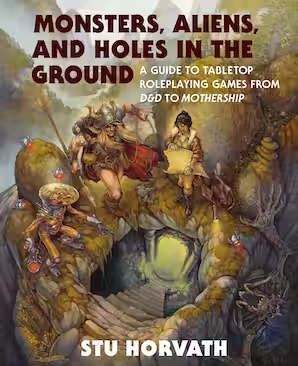Monsters, Aliens, and Holes in the Ground (Review)
For those interested in the history of tabletop roleplaying game design, Monsters, Aliens, and Holes in Ground is an excellent, near encyclopedic treatment. The author, Stu Horvath, documents major and minor game systems, how they innovated or were influenced by other game systems, and how the systems expanded with settings and adventures. Horvath covers the 1970s through the 2010s and, reading through the entries, chronicles the major changes in design theory from simulation, to forms of narrative, to today’s many experimental systems.

Stu Horvath and Kyle Patterson. Monsters, Aliens, and Holes in the Ground: A Guide to Tabletop Roleplaying Games from D&D to Mothership. MIT Press 2023. Publisher Link
I bought the standard edition and the book is weighty and beautiful. In fact, the book is a bit too heavy and can be uncomfortable to read in a chair. Over 400 pages long of heavy paper stock, almost all entries are annotated with at least one full-color image of the book being discussed. Each decade is introduced by a thematic two page illustration of the major game design thrusts by Kyle Patterson.
Organized by the publication date, the text supports a linear read-through as game systems influence later books. Horvath is fairly opinionated about what works and didn’t work within a design. This improves the readability, although, as an academic imprint, some of his arguments deserve greater support. (Horvath does pull from game journalists and many interviews with game designers.) I was pleased to finally learn the background of titles like Skyrealms of Jorune, which was advertised consistently in Dragon Magazine, but was sufficiently weird to remain obscure.
Although the book documents an extensive number of systems, it is not exhaustive. The author is open about this fact in the introduction. First, a system may not be included if he has never heard of it. Second, there are many systems (particularly foreign language) that he has not been able to acquire. Third, he excludes some systems if due to their subject matter or his disagreements with the creators. Of these, he only specifies Empire of the Petal Throne as eliminated. Thus, for some of the rare games in my collection that are not mentioned in the book, I do not know if their absence is intentional or inadvertent.
Additionally, the main threads of game design are described over many individual game entries. I think the book, and his arguments, would have been improved by a summary tying the major milestones together.
I recently visited a half-dozen game shops across three states and I was disappointed in the small RPG selection at the stores. If it’s not D&D 5e, they are unlikely to have it. In comparison, growing up, every store stocked multiple major systems and many had a deep catalog of used titles. So, I appreciate books like this that show the sheer range of the hobby and how designers have influenced and built upon each other’s innovation and experiments. Recommended.